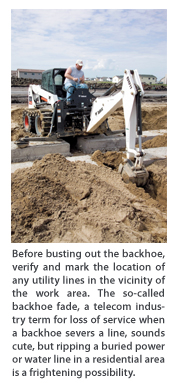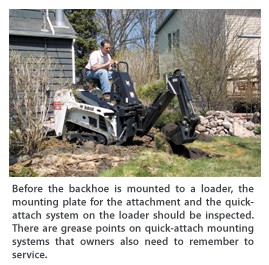Ensuring Excavation Operations
Digging a hole doesn’t mean you have to be buried in large expenses or missed timelines. Many owners of skid steer, compact track, all-wheel steer and compact utility loaders need to excavate occasionally in the work they perform. For those who don’t own an excavator, renting or purchasing one are options. Compact excavators certainly have their place and value, but for operators who dig only a few times a year, it’s difficult to justify the cost of purchasing an excavator. But what happens if a rental store or dealership does not have an excavator on hand to rent?
Why Backhoe Attachments?
For those in construction, building and grounds, agriculture and other applications, backhoe attachments for compact loaders are a popular solution. These attachments increase the versatility and utilization of existing loaders and are an economical alternative for users who don’t need a full-sized excavator.
Some backhoe attachments offer the same dig depth and reach as compact excavators. For example, Bobcat offers models of backhoe attachments that range from 6 to 11 ft in dig depth; compact excavators often have dig depths between 6 and 10 ft.

This low cost means those who don’t excavate often can have a backhoe attachment on hand when they need it. “A backhoe attachment is cheap and small enough that it can sit in a yard, and when needed, it’s guaranteed to be there without having to worry about a dealership or rental store having an excavator in stock,” says Odegaard.
For instance, those in buildings and grounds market may need to excavate to maintain lawn sprinkler systems, install electrical lines or plant trees. While these are not daily tasks, it’s convenient to have a backhoe attachment on hand to complete these jobs quickly when they do need to be completed.
The types of buckets and other tools available for use on backhoe attachments are similar to those that are used on excavators. Trenching and grading buckets are the most popular, and rippers and packer wheels can also be used on a backhoe attachment to break hard ground and compact soil in trenches.
If an operator is going to work at a jobsite where excavation is required, transporting the equipment may be a consideration. Owners who already have a trailer to transport their loader and attachments can use the same trailer to transport the loader and backhoe attachment.
Operating Backhoe Attachments
Odegaard says that while Bobcat does not require rear stabilizers or counterweights to be used with the company’s backhoe attachments on its loaders, owners should check with their manufacturer’s recommendations.
“Rear stabilizers transfer the weight of the loader to the front, providing more down force for more efficient digging,” says Odegaard.
Most backhoe attachments and loaders allow the operator to reposition the loader from the seat of the backhoe attachment. In many cases, the operator pushes a button in the loader cab that releases the parking brake so the loader can be repositioned. Once in the new location, the button is pushed again to re-engage the parking brake so work can continue. Odegaard cautions that operators should not move the loader more than a few feet while in the operator seat on the backhoe attachment. “Transporting the loader and attachment across the jobsite or other longer distances should be done from the loader operator seat,” says Odegaard.
Maintaining Backhoe Attachments
While a backhoe might not be the attachment an operator uses the most, it’s important to maintain them so they work when called on. Thankfully, maintenance of backhoe attachments is easy. As with any attachment, it’s a good idea to do a walk-around before operation. Items to inspect visually for damage include transport pins, locking levers, springs and safety chains.
Two of the most important maintenance items on a backhoe attachment are the cutting edge and bucket teeth. When these items become worn, the performance of the attachment is affected. The cutting edge and bucket teeth should be inspected regularly to ensure they are tight, sharp and undamaged. Wear on the bucket teeth is determined by the work conditions. Harder soils will wear on the bucket teeth more quickly than softer soils.
Hydraulic tube lines, hoses and quick couplers are other points that should also be routinely inspected. Operators need to make sure hose coverings aren’t scuffed or cut and quick couplers are free of dirt or other debris. The cylinders and valves should not be leaking and there should not be structural cracks on the workgroup or mounting frame.
Greasing is a simple maintenance practice that enhances the performance of a backhoe attachment and extends the attachment’s lifespan. Unfortunately, some owners don’t grease as often as they should. All the moving joints on the backhoe should be greased regularly.
The bucket, dipper and boom should be tight. If loose, it’s likely the pins or bushings might need replacement. Before starting work, an operator should run through a mechanical swing of the workgroup that returns the swing lever to the neutral position to see how much “play” exists. If this play is excessive, an adjustment or the replacement of the rack and pinion may be required. If the attachment has not been used in a while, there may be some air in the cylinders and the operator will have to swing the workgroup a couple of times to remove the air.

“Hoses, cylinders and bucket teeth should be inspected daily or before each time the backhoe attachment is used if it is not operated on a daily basis,” says Odegaard. “The operator should also walk around and grease the attachment daily or each time before use.”
Maintaining Quick-Attachment Mounting Systems
Before a backhoe, or any attachment, is mounted to a loader, the mounting plate for the attachment and the quick-attach system on the loader should be inspected. Odegaard says that operators should look for bent pieces and broken welds on the attachment mounting plate and the loader quick-attach system. Of course, these things should be fixed before the attachment is used. There are grease points on quick-attach mounting systems owners also need to remember to service.
Owners of loaders with quick-attach systems, which allow the operator to switch between attachments without getting out of the cab, should also look for hydraulic hoses that are leaking.
Whether your jobsite is a farm, school grounds or a construction site, a backhoe attachment may be a better solution than an excavator if you have a compact loader and need to excavate only occasionally. Smaller and less expensive than excavators, backhoes are reliable attachments if properly maintained. Adding to your attachment fleet increases the versatility of the compact loaders you already own. It also means that you can excavate as soon as you need to, without waiting to rent an excavator.
Eric Morse is a technical writer and public relations representative for Two Rivers Marketing, based in Des Moines, Iowa.






Comments are closed here.